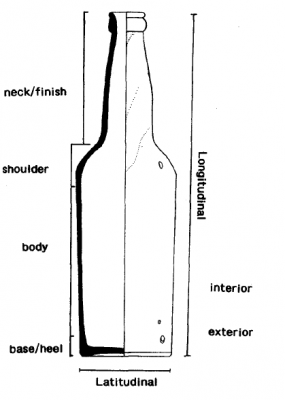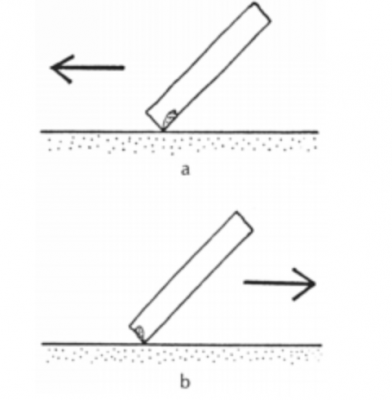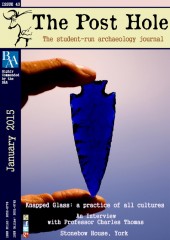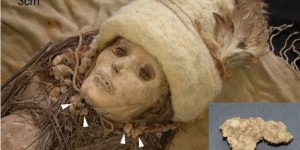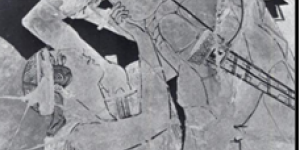Knapped glass, also known as lithic glass, worked glass, or flaked glass, can serve as an invaluable link between prehistoric and historic archaeology. The carrying over of the practice of making stone tools with a new medium was widely practiced, but has been sparsely reported on for multiple reasons. Perhaps the most obvious of these reasons is the trouble of identifying whether glass is truly modified by humans, or if it is just a result of fortuitous circumstances. Another problem that has plagued the study of knapped glass is the question of who used it, and for what purpose. Studies have been conducted in attempt to answer these questions, but more still need to take place. Knapped glass has been used by many cultural groups, including those in the Southwest United States as an expedient tool material, but it is also very commonly noted in more formal tools too, such as projectile points.
Use of glass as a medium, instead of the more traditional stone for making tools, was a way for indigenous groups to maintain a cultural identity whilst adapting to their new environment. In the post-Contact era, European goods became much more accessible with passing time. By the mid to late 1800’s, Euro-Americans had populated the United States from coast to coast and were forcing their lifestyles upon the indigenous population.
Introduction
Post Contact in the Americas, many ideas, customs, and goods were exchanged between the newly arrived Europeans and the indigenous populations. Once these interactions began, the two groups began to utilise these new customs and goods, quite often in a different way from the original population’s intended use. One such example of this change in use of customs and goods was the use of manmade glass by indigenous populations to make tools.
These historic tools provide many problems for analysts today. Distinguishing between accidental breaks and purposeful tools can be nearly impossible in some cases. But several studies have been carried out with varying success in attempt to more accurately identify these artifacts.
Perhaps the most important aspect of these tools though is not the identification of them today, but what these tools meant to those who made them. Knapped glass tools have been found in connection with Native American, African, and Euro-American contexts, but without an understanding of the use of these tools, identification is meaningless.
Identification
Identifying culturally flaked glass as distinct from accidently flaked glass is an issue that many analysts come across. Without careful excavation, even the slightest trowel scrapping can produce flakes on a shard of glass that can be mistaken for being worked (Blume 2000, Clark 1981). But even if the utmost care is taken during excavation, forces outside of archaeologists’ control can produce accidental flakes.
Blume conducted an experiment with only two bottles in an attempt to see if they could produce shards of glass that appear as if they were culturally flaked (1981). Their attempts at damaging, and then retrieving, the glass involved the simulation of the “effects of plowing, disking, and later excavation by placing pieces of two broken beer bottles – one Irish and one Danish – in a soil bed from which all other artifacts had been removed by sifting the soil. The bed was then shoveled, hoed, and raked repeatedly over the course of several hours. Finally, the broken glass was removed by sifting” (Blume 1981, 254).
There are issues with Blume’s experiment. Perhaps the most obvious is the sample size. Using only two bottles does not provide a large sample to examine. The second problem is the analysis of the bottles. The statement of the two bottles being “one Irish and one Danish” is more than likely a description of the alcohol they originally held, and not the origin of the actual glass bottles.
As expected, glass that is simply damaged accidently can appear to have been culturally flaked. With this potential problem, Blume also suggests a solution. The presence, or absence, of patina can be a vital indicator as to the age of the flakes on the glass. But this indicator is not absolute. It is very likely that old damage could have occurred and produced accidental flakes.
Quantitative approach and its problems
Perhaps the best method of identification, though, is not something quantitative. As Cooper and Bowdler said of flaked glass artifacts, “acceptance of these specimens appears to be entirely subjective” (1998, 75). A quantitative approach to flakes, retouching and tool shape simply cannot replace the knowledge of what a traditional glass tool from the respective region would appear to be.
Despite these problems, many have attempted to set a standard on how knapped glass appears (Boot 1987, Clark 1981, Niemoeller and Guse 1999). These attempts range from how the worked edge appears after use-wear, to how long the flake scars are on glass when it has been culturally knapped, as opposed to accidental damage.
Perhaps one study is not satisfactory for the determination of whether or not a shard of glass is actually deliberately flaked. There are many factors to consider, the most basic being colour. A preference towards dark green to black coloured bottles for example (Allen & Jones 1980, Kimura 2006, Whitehead 2009). Also, the portion of the bottle can potentially be important. It has been noted in several studies that a preference towards the thick parts, particularly the base or heel (Fig. 1), of the bottle is common (Allen & Jones 1980, Blume 2000, Cooper & Bowdler 1998, Flexner & Morgan 2013, Ulm et al 1999, Wilkie 1996).
More advanced analysis of the glass artifacts can also reveal whether it has been culturally flaked or if it is accidental. Assessment of glass flakes “patterning consisted of a cluster of overlapping, shallow, scalar scars along one edge of a side” (Clark 1981, 32). The angle of the flakes has also been noted as possibly being significant to glass flakes, particularly 60 to 90 degrees (Cooper & Bowdler 1998, Whitehead 2009). The length of the flake scars also potentially serve as signifiers of culturally flaked glass. Niemoeller and Guse (1999) suggest a mean flake scar was 3.8mm, a median of 2mm and mode of 2mm.
The angle of the glass flakes could also signify potential uses for the glass tool. Wilkie states “… whittling activities are usually associated with acute angles, whereas planing is usually more associated with more obtuse edge angles” (1996, 42). Approaching analysis from this direction could give a much deeper understanding of what the tool was truly used for.
Directionality of the use wear has also been examined in previous studies (Clark 1981). Clark observed that use-wear on glass tools occur on the side opposing the force (Fig. 2). With this observation in mind, it may aid in further examination of Wilkie’s assessment of different angles of glass tools being used for cutting or planing.
Knapped glass in Europe|
Flaking glass was not a tradition practiced only by indigenous populations of the Americas. There is evidence of tools being made in England as early as ca. 1700 CE (Whitehead 2009, 28-30). A worked flake of glass from an onion bottle made of black glass was found in south-central England in what appears to have been a hunting camp. Whitehead speculates that the use of glass as a tool may have been a sign of marginalised people, meaning people on the outside, looking in on mainstream society, possibly due to financial, spatial or social factors.
As further evidence for tools made of glass in Europe, Whitehead discusses a piece of window glass potentially dating to ca. 200 CE (Whitehead 2009, 28-30). This glass would have been used as a tool during the Early Romano-British period. Perhaps the largest indicator of this fragment actually having been used as a tool, and not simply accidentally broken by some unknown forces over the past eighteen hundred years, is the presence of grinding on the edge of the glass directly opposite of the flaking. This grinding dulled the edges of the glass and facilitated the placing of a finger on this portion of the tool.
When Europeans began migrating to the United States, they brought this knowledge of knapping with them as discussed above. The colonisers “were making and repairing gunflints and fire flints into the 19th century, and [they] would have had the knowledge to create an expedient scraper or cutting edge on a piece of chert or glass” (Beaudoin 2013, 76). Having knowledge such as this would prove helpful when in need of a quick tool. This knowledge was a tool the Euro-Americans had in their belt for when it was necessary, but is widely overlooked due to lithic/glass knapping being examined primarily as an indigenous technology.
Knapped glass in Arizona and U.S.
Arizona has been a home to many Native American tribes throughout prehistory, history and into the present. The occurrence of knapped glass is a certainty at many sites. Despite this fact though, the presence of knapped glass in literature of the region is sparse at best (Ayers et al. 1994, Flexner & Morgan 2013).
Glass working is present at the Indian School in Phoenix, Arizona (Flexner & Morgan 2013, Lindauer 1998). It is possible that the use of glass, and also ceramics at this particular site, was an attempt at maintaining a cultural identity while being forced to assimilate to a Euro-American culture. A similar case has been noted at the colonial Native American boarding school set up in Williamsburg, Virginia, which also had flaked glass tools found in connection with the students (Seurattan 2011). This small resistance is proof that while appearing to be absorbed into the schools systems set up by the United States government for Native Americans, the students were still practicing and maintaining their culture in a more subtle way.
Also found at the Indian School in Phoenix, Arizona are pot sherds (Lindauer 1998), but pot-making is not a taught practice at the school. This serves as further proof that the Native American students are actively resisting Euro-American culture being forced upon them whilst studying and living at the boarding schools.
Knapped glass has been identified in archaeological contexts in other regions of the United States. For example, Wilkie’s (1996) examination of flaked glass in African-American communities of Louisiana is well known. The primary use noted in the article is woodworking, with glass being used as an expedient tool and not curated. Wilkie states that knapped glass tools “may, in fact, represent tools of convenience rather than forethought” (1996, 44). This is similar to the utilitarian use of worked glass by the Euro-American settlers as mentioned previously in the article.
Wilkie also states that glass knapping may have been a “specialized skill note shared by the entire [African American] tenant population” (1996, 45) at her examined site of Oakley Plantation in Louisiana. This sheds new light on the practice, possibly for all cultures and not just the African Americans living in antebellum and postbellum Oakley Plantation. Despite this specialisation’s usefulness, as Wilkie surmises, it was soon to die out with the advent of a more widely available blade, which could serve as both a tool for cutting and scrapping.
The early American frontier has also shown evidence of knapped glass. Several sites in Colorado also had knapped glass artifacts present (Nelson et al. 2008). But these particular artifacts may be different from the utilitarian, or cultural ways previously discussed. The contexts that the artifacts were found in may suggest that some of these tools were made for religious purposes. A “[r]eligious sect active in New Mexico and Colorado”, known as the Penitentes, was known to use lithics and flaked glass as an integral part of some of their ceremonies. Despite this being a possibility, the artifacts are still classified as “Native American/Hispanic”, due to the lack of conclusive evidence. This all being said, Hispanics in Colorado did also use glass tools in an expedient fashion as well.
Conclusions
The identification of glass tools is no easy task. There are many different attributes to consider when determining if a piece of glass has been culturally flaked, or whether it merely reflects the result of fortuitous circumstances.
Glass knapping can be simply a tool, as seen in Europe and with Euro-American colonisers. This is also seen in African-American communities. Glass is an abundant and easily workable material, so this activity would only take a small amount of training and practice to gain a working understanding of how the tools are made.
However, knapped glass can have a much deeper cultural or religious meaning. The Native American students at the Indian School in Phoenix, Arizona practiced glass flaking as a way of maintaining culture in a Euro-American structured setting. Penitentes also used knapped glass as part of their religious ceremonies in the Southwest.
Perhaps the state of the studies of knapped glass is best summarized in this statement about the studies presently being undertaken in Canada:
“The issue here is determining how these varied dispositions differentially engage with the material world and become expressed in the archaeological record. For example, chipped glass could be indicative of Aboriginal dispositions, but framing it as such without deconstructing why this association is made frames the discourse in a manner that minimizes other possibilities. Could chipped glass also be a disposition of a poor European man, or even a woman or child? Alternatively, could chipped glass be the simple result of the functional necessity of the time that may be divorced from any broader dispositions? Why should our preconceptions limit our interpretations without a reflexive evaluation?” (Beaudoin 2013, 36).
Flaked glass is an uncommon artifact to encounter, but can be more easily identified with some research and knowledge of the traditions underpinning the local area. But without the knowledge of who was using the tool, and what the knapped glass meant to them, the tool is useless to archaeologists today.
Bibliography
- Allen, J. and Jones, R. (1980). Oyster Cove: Archaeological Traces of the Last Tasmanians and Notes on the Criteria for the Authentic of Flaked Glass Artefacts. Papers and Proceedings of the Royal Society of Tasmania. 114, 225-233.
- Ayres, J. E., Rogge, A. E., Keane, M., Douglas, D. L., Bassett, E. J., Fenicle, D. L., Myers, C. L., Clark, B. J. and Turnmire, K. (1994). The Historical Archaeology of Dam Construction Camps in Central Arizona. Sites in the Roosevelt Dam Area. Prepared for the U.S. Bureau of Reclamation, Phoenix.
- Beaudoin, M. A. (2013). De-essentializing the Past: Deconstructing Colonial Categories in 19th–Century Ontario. Ph.D. dissertation. Department of Anthropology, University of Western Ontario, London, Ontario.
- Blume, C. (2000). “Making Do With Broken Glass”. In Heite, E. F. and Blume, C. L. (Eds). Mitsawokett to Bloomsbury: Archaeology and History of an Unrecognized Indigenous Community in Central Delaware. Dover: Delaware Department of Transportation. 247-269.
- Boot, P. (1987). Trampling Damage on Stone Artefacts – Some Experimental Results. Australian Archaeology. 24,10-15.
- Clark, J. T. (1981). Glass Scrapers from Historic North America. Lithic Technology. 10,31-34.
- Cooper, Z. and Bowdler, S. (1998). Flaked Glass Tools from the Andaman Islands and Australia. Asian Perspectives. 37(1), 74-83.
- Flexner, J. L. and Morgan C. L. (2013). ”The Industrious Exiles: An Analysis of Flaked Glass Tools from the Leprosarium at Kalawao, Moloka”. In Card, J. J. (Ed). The Archaeology of Hybrid Material Culture. Illinois: Southern Illinois University Press. 295-317.
- Goward, T. (2011). Aboriginal Glass Artefacts of the Sydney Region. B.A. honours thesis, Department of Anthropology. Sydney: University of Sydney.
- Gibbs, M. and Harrison, R. (2008). Dynamics of Dispersion Revisited? Archaeological Context and the Study of Aboriginal Knapped Glass Artefacts in Australia. Australian Archaeology. 67, 61-68.
- Harrison, R. (2003). The Magical Virtue of These Sharp Things: Colonialism, Mimesis and Knapped Bottle Glass Artefacts in Australia. Journal of Material Culture. 8 (3), 311-336.
- Kimura, B. (2006). Knapped Glass Tools from Konso, Southern Ethiopia. Paper presented at the Society of Africanist Archaeologists Conference in Calgary, Canada.
- Lindauer, O. (1998). Archaeology of the Phoenix Indian School. Archaeology Magazine.
- Nelson, S. M., Berry, K. L., Carrillo, R. F., Clark, B. L., Rhodes, L. E. and Saitta, D. (2008). Denver: An Archaeological History. University Press of Colorado, Boulder, Colorado.
- Niemoeller, G. and Guse, D. (1999). Inter-Regional Variation in Glass Bottle Reduction Technology in the Northern Territory. Australian Archaeology 45, 47-48.
- Paterson, A. G. (2008). The Lost Legions: Culture Contact in Colonial Australia. Maryland: Altamira Press.
- Russell, C. P. (1967). Firearms, Traps, & Tools of the Mountain Men. New Mexico: University of New Mexico Press.
- Seurattan, S. (2011). Dig sheds light on College’s early history. Available at: http://www.wm.edu/news/stories/2011/brafferton-project-unearths-foundati... Accessed on: 29th October 2014.
- Shackley, M. (2005). Obsidian Geology and Archaeology in the North American Southwest. Arizona: University of Arizona Press.
- Silliman, S. (2001). Agency, practical politics and the archaeology of culture contact. Journal of Social Archaeology. 1 (2),190-209.
- Ulm, S., Eales, T. and L’Estrange, S. (1999). Post-European Aboriginal Occupation of the Southern Curtis Coast, Central Queensland. Australian Archaeology. 48, 42-43.
- Wescott, D. (ed) (1999). Primitive Technology A Book of Earth Skills. Utah: Gibbs-Smith Publisher.
- Whitehead, P. F. (2009). Knapped Glass form the Bredon Hill Area of Worcestershire. Worcestershire Record. 26, 28-30.
- Wilkie, L. A. (1996). Glass-knapping at a Louisiana Plantation: African-American Tools? Historical Archaeology. 30 (4), 37-49.


